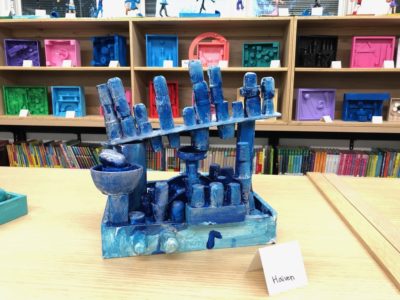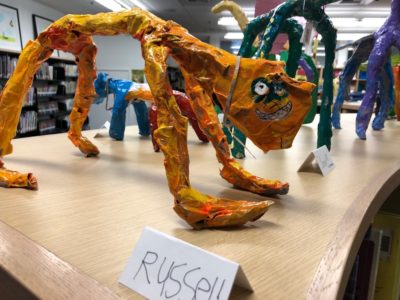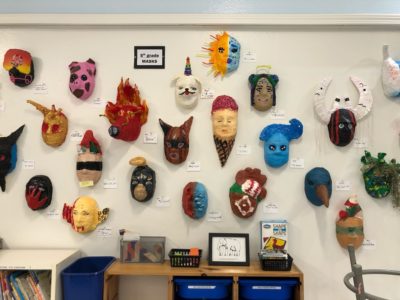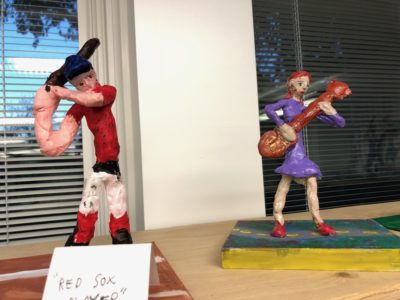The art program in grades 3-6 begins each year with open-ended, fine-art projects that later evolve into social studies and science integrated projects throughout the year. Those integrated works are displayed at culminating festivals in May and June. Enjoy this look at all the completed art projects currently on exhibition at the elementary campus!
3rd Grade Wood Assemblages
After viewing the work of American Sculptor Lousie Nelvelson, 3rd graders were invited to make a “practice” sculpture by cutting cardboard to create a pattern of shapes that were glued into a discarded boxtop. Then students selected a saturated (pure color) and practiced mixing tints (with white) and shades (with black) to find the color they wanted to paint it. The same process was applied to create the Wood Assemblages, with the added element of “found objects” that students brought from home. The class had fun selecting and sanding the various wood pieces which they assembled in their wooden cigar box. Next, they integrated their found objects (small toys, plastic spoons, beads, etc.) glued everything into place then painted the work to unify the piece. They make a powerful statement displayed in concert with one another
4th Grade Paper Mache Creatures
These beautiful creations were made from ordinary household items – two wire hangers, newspaper, and masking tape. 4th graders enjoyed the process of making “something” from nothing” (that is, using materials that most people would not consider art supplies). After shaping the skeleton of their creature in wire, students taped on rolled up pieces of newspaper to create the muscle mass then they applied strips of newspaper dipped in starch over the surface to make the “skin.” Next, they mixed a solid color for their base coat, added a pattern or design on top and an optional topcoat of glass or matte medium.
5th Grade Masks
5th graders viewed masks from around the world and learned about the various roles they can play in theater, opera, dance, and ceremony to tell stories, heal, conceal and reveal identities, celebrate holidays, and honor ancestors. Next, they built the foundation of their mask out of plaster gauze on a plastic face mold base. Students were then invited to “DESIGN THEIR OWN MASK”—using distortion, exaggeration, symmetry, and facial expressions—and to incorporate a 3-D element with foil and/or cardboard. Finally, they painted and adorned their masks with pipe cleaners, rhinestones, string, and sequins to enhance their expression.
6th Grade Clay Figure Sculptures
Being all together again in person, it seemed fitting to open this school year with a figure sculpture project that started with 6th graders drawing each other. They took 3-5 minute poses and sketched each pose to learn scale and proportion. Next, they drew from various poses from desktop mannequins and finally, made a small scale wire “armature” to create a gesture—a figure in motion—doing an activity—such as dancing, running, surfing, skateboarding, etc. The students then added Sculpey clay for muscle mass. These pieces were oven-baked, painted, then placed on a base or platforms to further customize and enhance the activity.





